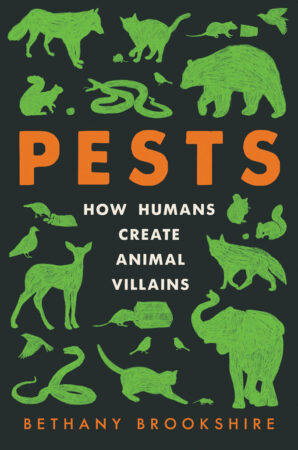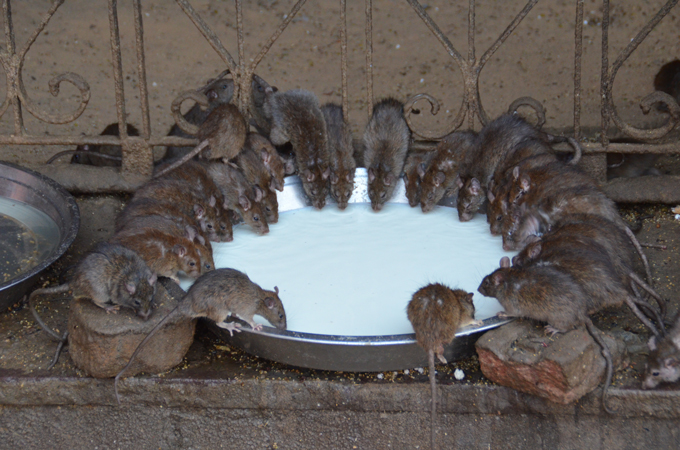
Pests
Bethany Brookshire
Ecco, $28.99
We spend so much time making sure wildlife stays away from us, whether that’s setting traps, building fences or putting out poisons. Sure, unwanted guests are annoying. But why do we consider some animals “pests”? It’s all about perspective, says science journalist Bethany Brookshire. “We can put poison out for rats and protest their use as laboratory animals. We can shoot deer in the fall and show their adorable offspring to our children in the spring,” she writes in her new book, Pests: How Humans Create Animal Villains.
Brookshire argues that we deem animals “pests” when we fear them (like snakes). Or when they thrive in a niche we unintentionally created for them (think rats in the New York subway). Or when they find a way to live in a habitat now dominated by humans (all those deer in the suburbs). Sometimes we demonize an animal if we feel like it’s threatening our ability to control the landscape (like coyotes that attack our livestock, pets and even children).
Through the lens of science, history, culture, religion, personal anecdotes and a big dose of humor, Brookshire breaks down how our perspective shapes our relationships with our animal neighbors. She also goes into the field — trailing rats, hunting pythons, taming feral cats, tracking drugged-up bears — to see firsthand how pests are treated.
Science News spoke with Brookshire, a former staff writer for Science News for Students (now Science News Explores), about what we can learn from pests and how we can coexist with them. The following conversation has been edited for clarity and brevity.
SN: What inspired you to write this book?
Brookshire: I wrote a news story that was about mice living with humans (SN: 4/19/17). [It was based on a study] showing that we’ve had house mice since we’ve had houses. I love the fact that humans have had these other animals taking advantage of the ecosystems that we create basically since we started living settled life. Every location that has humans has their “rat.” Sometimes that’s a rat, and sometimes it’s a pigeon or a cockatoo or a lizard or a horse. It’s not about what these animals are doing. Animals live in ecosystems that we create, and we hate animals that live too close.
SN: What surprised you during your research?
Brookshire: The reflexiveness of people’s responses [to pests]. People respond emotionally. When you make them pause and think about it, they go, “Oh wow, that doesn’t make any sense. I should not be caught trying to kill a raccoon with a sword.” But in the moment, you’re so wrapped up in the violation of what you see as your personal space.
The other thing is the extent to which our disdain of pests is wrapped up in social justice. A lot of times we see this hatred and disgust for animals that we see as “low class.” High-class people don’t have rats. And that’s really about social justice, about infrastructure and the ability of people to live in clean houses, store their food properly or even have a house at all.
Also, the way we deal with these animals often has vestiges of colonialism, as in the chapter on elephants. [In Kenya, European colonists] made people grow corn and sugarcane, which elephants love. Colonization created national park systems that assumed that humans had no place in wilderness, shoving out Indigenous pastoralists. Colonization created the market for poached ivory. And colonizing people assumed that Indigenous people did not like elephants or know their benefits. We are living with the consequences. Many modern efforts at elephant protection are spearheaded by Western people, and they assume the biggest issue with elephants is poaching and that Indigenous people don’t know what’s best for themselves or the elephants. In fact, human-elephant conflict [which includes elephant crop raids] is the far bigger problem, and Indigenous people have a long history of coexisting with elephants.
SN: In the book, you looked at many different cultures and included Indigenous voices.
Brookshire: It’s important to realize there’s more than one way to look at the world. By learning from other cultures, it helps us understand our biases. It’s only when you get outside of your own beliefs that you realize that’s not just the way things are.
SN: That shows up when you write about the Karni Mata Temple in India, also known as the Temple of Rats. Temple rats are not treated as pests, but a rat in a house would be.
 India’s Karni Mata Temple is home to thousands of black rats, which devotees believe are people reincarnated as rats by the goddess Karni Mata. The rats are given meals and milk in large bowls. In other contexts, rats are usually unwelcome visitors.Credit: Günther Jontes/Wikimedia Commons (CC BY 4.0)
India’s Karni Mata Temple is home to thousands of black rats, which devotees believe are people reincarnated as rats by the goddess Karni Mata. The rats are given meals and milk in large bowls. In other contexts, rats are usually unwelcome visitors.Credit: Günther Jontes/Wikimedia Commons (CC BY 4.0)
Brookshire: That’s the result of context. And you see that in Western cultures all the time. People love squirrels. Well, they’re basically rats with better PR. Then you have people who have pet rats, who would probably scream if a sewer rat ran by.
SN: Are there any animals that you consider a pest?
Brookshire: No. The animal that I’ve probably come away with the most negative impression of is humans. It’s funny because we think we can extinct anything. And I love how these animals have gone: “Oh, poison? That’s cute.” “Oh, a trap? You’re funny.” We’ve tried to use electric fences on elephants [to stop them from eating crops]. And elephants are like, “Guess what? Ivory doesn’t conduct electricity.” Even if they don’t have tusks, elephants just pick up a log [to destroy the fence].
SN: Are you hoping to change people’s minds about pests?
Brookshire: I hope that they will ask why they respond to pests the way they do. Instead of just going, “This animal bothers me,” ask why, and does it make sense. I also hope it opens more curiosity about the animals around us. I learned from Indigenous groups just how much knowledge they have of the animals in their ecosystem. I hope more people learn. A world that you know a lot about is just a better world to live in.
Buy Pests from Bookshop.org. Science News is a Bookshop.org affiliate and will earn a commission on purchases made from links in this article.

